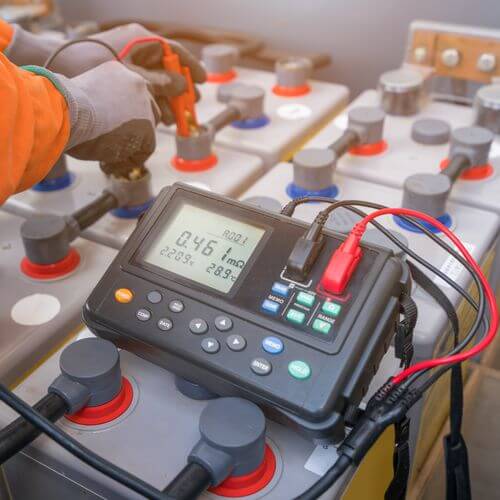Battery Health Analysis
Battery maintenance and testing is crucial to the continued performance of a UPS system. There are a variety of common battery tests including impedance testing and discharge testing, more commonly known as load bank testing.
Most uninterruptible power supplies have bult-in functionality that automatically tests their batteries regularly, typically every 24 hours, and will alarm if it detects a battery fault.
Such tests place a load onto the battery set and monitor the discharge performance. However, this only offers a general indication of the overall set. It doesn't provide an individual cell level report. Similarly, just measuring the float voltage across a battery set doesn't provide a true indication of its condition.
The best way to assess the true state of a large battery set is through external battery testing. For large battery sets, individual block testing can be more reliable.

External battery testing should form part of a planned preventive UPS maintenance regime, although it can also be provided as a standalone service.
Why does a battery age?
The state of health (SoH) of a battery deteriorates over time. This is caused by:
-
Calendric aging: The battery ages without being used, simply due to time. This process is influenced, in particular, by the ambient temprature.
-
Cycling aging: It depends on the type of use, but above all on the operating cycles, the (dis)charging stroke, the end-of charge volatge, and the strength of the charging and discharging currents. The possible number of cycles is determined by the type and quality of the rechargeable batteries and the temperature.
Methods We Implement to Perform Battery Health Analysis:
-
Impedance Testing
This is a non-intrusive test designed to bulid up a performance history of each battery cell. It is typically undertaken annually as this enables performance to be tracked over time. This makes it easier to identify any signs of deterioration or any cells with high internal impedance that might require replacing.
Impedance testing involves applying an AC current to each battery via probes attached to the block terminals. Impedance is measured and recorded in milliohms.
It gives a general indication of the batteries status without placing them under too much stress or needing to take them offline.
-
Load Bank Testing ( Discharge Testing)
This is the most comprehensive battery test and the only true examination that determine the actual capacity of the battery string. Load bank testing audits the batteries under both normal and peak load conditions. This demonstrates which cells hold the charge and highlights which might be approaching their end of service life.
The Institute of Electrical and Electronics Engineers (IEEE) recommends performing discharge testing at the time of installation, then repeating the test every year.
The main drawback of load bank testing is that the UPS batteries must be taken out of service during the test. Usually the batteries are available again within 24 hours, although in the worst-case scenario this can last for several days.
Vidhyut Engineering
Shree Krishna Park Society,
Himalaya Mall Road,
Bhavnagar-364001,
Gujarat, India